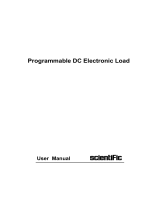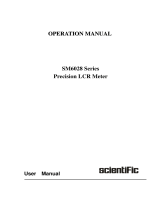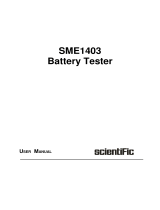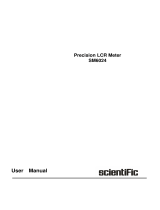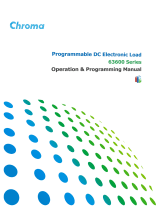Page is loading ...

User Manual
Programmable DC Electronic Load
SME1700+ Series

Scientific
User Manual SME1700+ 2/64
Copyright © Scientific All rights reserved.
This instrument contains proprietary information, no part of this manual may be photocopied,
reproduced or translated without any prior written consent.
Information in this manual supersede all corresponding previous released material.
Scientific continues to improve products and reserves rights to amend part or all of the
specifications, procedures, equipment at any time without notice.
Rev 1.1/ 0920
Scientific Mes-Technik Pvt. Ltd.,
B-14 Industrial Estate, Pologround,
Indore- 452015 (India)
Tel : 0731-2422330/31/32/33
Fax : 0731-2422334,561641
Email : info@scientificindia.com
Website: www.scientificindia.com

Scientific
User Manual SME1700+ 3/64
Table of Contents
Technical Specifications ...................................................................................... 5
1. Overview ............................................................................................................. 7
1.1 Introduction ................................................................................................... 7
1.2 Environmental Conditions ............................................................................. 7
1.3 Weight & Dimensions ................................................................................... 8
1.4 Safety requirements ..................................................................................... 8
1.5 Electromagnetic Compatibility ....................................................................... 8
2. Panels ................................................................................................................. 9
2.1 Front Panel ................................................................................................. 9
2.2 Rear Panel ................................................................................................ 10
2.3 Basic Display Area Description ................................................................. 11
2.4 Summary of displayed page ...................................................................... 12
3. Function Setting and Use .................................................................................. 13
3.1 Static Mode ............................................................................................... 13
3.1.1 Constant Current (CC) ..................................................................... 14
3.1.2 Constant Voltage (CV) ..................................................................... 14
3.1.3 Constant Resistance (CR) ................................................................ 15
3.1.4 Constant Power (CP) ....................................................................... 15
3.2 Dynamic Mode .......................................................................................... 15
3.3 Sequential Operation (List) ....................................................................... 16
3.4 CR-LED .................................................................................................... 18
3.5 Battery Test (Battery) ................................................................................ 19
3.6 Time Test (Timing) .................................................................................... 20
3.7 Overcurrent Protection Test (OCPT) ......................................................... 21
3.8 Over Voltage Protection Test (OVP) ......................................................... 22
3.9 Oppt .......................................................................................................... 23
3.10 Load Effect ............................................................................................... 23
3.11 Sweep ...................................................................................................... 24
3.12 Automatic Test (AUTO) ............................................................................. 25
4. System Setup .................................................................................................... 29
4.1 SYSTEM Setup (System) ......................................................................... 29
4.2 Load Unload (Von/Voff) ............................................................................ 31
4.3 Security Setting (Protect) .......................................................................... 32
4.4 File Store .................................................................................................. 32
4.5 Communication Setup (RS232) ................................................................ 34
5. Other Functions ................................................................................................. 36
5.1 Short Circuit Test Function........................................................................ 36

Scientific
User Manual SME1700+ 4/64
5.2 USB Interface Function ............................................................................. 36
6. Interface and Communication ............................................................................ 37
6.1 Remote Control Interface .......................................................................... 37
6.2 Command Specification ............................................................................ 40
6.3 Command Reference ................................................................................ 43
7. Handler .............................................................................................................. 61
7.1 Basic Information ...................................................................................... 61
7.2 Operation Instruction................................................................................. 61
8. Service & Maintenance ...................................................................................... 63
9. Warranty Conditions .......................................................................................... 64

Scientific
User Manual SME1700+ 5/64
Technical Specifications
Technical Specifications SME1701+ SME1701A+ SME1703+ SME1703A+ SME1703B+
Input
Voltage 150V 500V 150V 500V 150V
Current 30A 15A 30A 30A 60A
Power 175W 175W 350W 350W 350W
Min.
Operating
Volt.
1.5V@30A 1.8V@15A 1.2V@30A 3V@30A 1.5V@60A
Min. Rising
Time 20µS
Operating Mode Constant Current (CC) Mode, Constant Resistance (CR), Mode, Constant
Voltage (CV) Mode and Constant Power (CP) Mode
Voltage
Range 0-
15V
0-
150V
0-
50V
0-
500V
0-
15V
0-
150V
0-
50V
0-
500V
0-
15V
0-
150V
Setting
Resolution
0.2
mV
2
mV
0.2
mV
2
mV
0.2
mV
2
mV
0.2
mV
2
mV
0.2
mV
2
mV
Setting
Accuracy
0.05% + 0.05% FS
Measurement
Resolution
1
mV
10
mV
1
mV
10
mV
1
mV
10
mV
1
mV
10
mV
1
mV
10
mV
Measurement
Accuracy
0.08% + 0.05% FS
Current
Range 0-
3 A
0-
30 A
0-
1.5A
0 –
15A
0-
3A
0-
30A
0-
3A
0 –
30 A
0 –
6A
0 –
60A
Setting
Resolution
0.05
mA
0.5
mA
0.05
mA
0.5
mA
0.05
mA
0.5
mA
0.05
mA
0.5
mA
0.1
mA
1
mA
Setting
Accuracy
0.05% + 0.05% FS
Measurement
Resolution
0.1
mA
1
mA
0.1
mA
1
mA
0.1
mA
1
mA
0.1
mA
1
mA
0.1
mA
1
mA
Measurement
Accuracy 0.08% + 0.05% FS
Resistance
Range 0.05Ω -
30kΩ
0.12Ω -
30kΩ
0.04Ω-
30kΩ 0.1Ω - 30kΩ 0.03Ω -
20kΩ
Resolution 0.1Ω
Accuracy 1%
Power
Range 0 - 175W 0 - 175W 0 - 350W 0 - 350W 0 - 350W
Resolution 10 mW
Accuracy 0.5% + 0.1% FS
Dynamic Mode
Dynamic
Mode
Range 20 µS to 60 S
Resolution 2 µS
Accuracy 1 µS + 100 pp
Rising Slope 0.6 A/ms –
1.5 A/µs
0.3 A/ms -
0.75 A/µs
0.6 A/ms -
1.5 A/µs
0.6 A/ms –
1.5 A/µs
1.2 A/ms –
3 A/µs

Scientific
User Manual SME1700+ 6/64
Measurement
Ripple
Range 0 -
15V
0 -
150V
0 -
50V
0 -
500V
0 -
15V
0 -
150V
0 -
15V
0 -
150V
0 -
15V
0 -
150V
Band Width 250 kHz
Accuracy 0.1%
Protection Function Over Voltage Protection (OVP) Over Current Protection (OCP), Over Power
Protection (OPP)
Storage Internal 20 groups
General Specifications
Interface RS232C, Handler
Power Source Voltage : 220 V ± 10%, Frequency 50 Hz/60Hz ± 5%
Power Consumption < 50 VA
Temperature 0˚C - 40˚C
Humidity < 90%
Dimensions W : 350 x H : 122 x D : 425 mm
Weight 3 kg 4.8 kg
Standard Accessories Mains Cord, CD
.

Scientific
User Manual SME1700+ 7/64
Chapter 1 Overview
1.1 Introduction
SME1700+ series is a DC electronic load with high precision, high intelligence and
easy operation. This series of instruments integrates a variety of test functions, has
excellent performance, and adopts TFT LCD display, which is clear and easy to
operate. It can meet the needs of rapid operation on the production site and the needs
of high accuracy and stability in the laboratory.
The special functions and advantages of the instrument are as follows:
500kHz synchronous sampling, 0.1mA, 1mV resolution
Voltage/current ripple, peak, peak and valley measurement
A dozen measurement functions
Support remote compensation function
Support file storage function
480X272 pixels, 24-bit color, 4.3-inch color TFT LCD screen, used to set test
conditions and display of measurement results, etc.
Number keyboard and knob operation
High accuracy and high resolution
Low ripple and low noise
Intelligent fan control, save energy and reduce noise
Software control and detection can be done by computer
Dual-range programmable voltage and current load
1.2 Condition of Use
1.2.1 Power
Power supply voltage: 220V (1±10%)
Power frequency: 50Hz/60Hz (1±5%)
Power consumption: <50VA
1.2.2 Ambient temperature and humidity
Normal working temperature: 0℃~40℃, humidity: <90%RH
Reference working temperature: 20℃±8℃, humidity: <80%RH
Transportation environment temperature: 0℃~55℃, humidity: 93%RH
1.2.3 Warm-up Time:
Warm-up time after starting: ≥ 20 minutes
1.2.4 Points to Note
(1) Please do not use it in bad environments such as dust, vibration, direct sunlight,
corrosive gas, etc.

Scientific
User Manual SME1700+ 8/64
(2) The instrument is not used for a long time, please store it in it’s original packaging
box or similar box in a ventilated room with a temperature of 5℃~40℃ and a
relative humidity not more than 85%RH. The air should not contain a corrosion
measuring instrument Harmful impurities and direct sunlight should be avoided.
(3) This instrument has been carefully designed to reduce the noise interference
caused by the AC power input, but it should still be used in a low noise environment
as much as possible. If it cannot be avoided, please install a power filter.
(4) There is a cooling fan at the rear of the instrument, and there are cooling vents on
the left and right to avoid the internal temperature rise affecting the accuracy.
Please ensure that the instrument is in a well-ventilated state.
(5) Do not switch the instrument frequently to avoid the loss of stored data.
1.3 Weight and Dimension
Dimension (W*H*D): 350mm*122mm*425mm
Weight: SME1701+, SME1701A+ : 3kg approx..
SME1703+, SME1703A+, SME1703B+ : 4.8kg approx..
1.4 Safety Requirement
This instrument is a Class I safety instrument
1.4.1 Insulation Resistance
Under the reference working condition, the insulation resistance between the power
terminal and the shell is ≥ 50M;
Under humid and hot transportation conditions, the insulation resistance between the
power terminal and the housing is ≥ 2M;
1.4.2 Insulation Strength
Under the reference working condition, the AC voltage between the power terminal
and the housing can withstand the rated voltage of 1.5kV and the frequency of 50Hz
for 1 minute without breakdown or arcing.
1.4.3 Leakage Current
Leakage current is not greater than 3.5mA.

Scientific
User Manual SME1700+ 9/64
Chapter 2 Panels
The content of this chapter is only a brief description. For specific operation and detailed
explanation, please refer to the corresponding content in Chapter 3.
2.1 Front Panel
1 USB Interface U Disk Interface
2 Trade Model Make & Model Number
3 LCD 480*272 dot matrix LCD display, showing all measurement
parameters, status, measurement results, etc.
4 Left and right arrow
keys
Used to move the cursor or turn pages
5 Knob for moving cursor up and down and value adjustment
6 Numeric keypad for entering values
7 [ON/OFF] Key Load start or stop button
8 [DISP] Key Enter the function setting page
9 [SETUP] Key Enter the system settings page
10 [SHORT] Key Shortcut key for short circuit test
11 [LOCK/LOCAL] Key
Used to lock the key to switch the remote control. When the
key is on, the keyboard is locked and the instrument can only
be controlled remotely
12 [TRIG] Key Trigger button for specific functions
13 [ENTER] Key Confirmation button for numerical setting
14 (POWER) Turn on or off 220V mains power, turn on the power when in
Figure2-1
1
2
3
4
5
6
7
1
2
1
3
1
7
1
6
8
9
1
0
1
1
1
4
1
5

Scientific
User Manual SME1700+ 10/64
the pressed position; turn off the power when in the ejected
position
15 SOFTKETs
The functions of the six keys in this part are not fixed, and
correspond to the functions of the soft key menu bar in the
corresponding LCD screen.
16 INPUT Load input port
17 Remote
Compensation
(SENSE)
The instrument selects the measurement port for remote
measurement
Table 2-1
2.2 Rear Panel
1 Three-wire power
socket for connecting 220V/50HZ AC power supply
2
Current monitoring
terminal
(I-MONITOR)
Used for current detection on the rear panel, output (0-10V)
3 HANDLER Instrument interface signal input and output port
4 RS-232C Serial communication interface
5 Nameplate Record production date, model, batch number, manufacturer,
etc.
Table 2-2
Figure 2-2

Scientific
User Manual SME1700+ 11/64
2.3 Basic Display Area Description
(1) Title bar: displays the name of the current page.
(2) Information prompt area: real-time display of load prompt information or error
information.
(3) Working mode display area: displays the working mode during static operation.
(4) Parameter setting area: used for parameter setting under the current function.
(5) Sampling display area: real-time display of various test results sampled.
(6) Status information area: display the current range of the load, short circuit, power
part temperature and other working status.
(7) Software menu area: corresponds to the soft keys on the front panel, and
corresponds to various operations according to the menu information.
2.4 Summary of the Displayed Page
2.4.1 DISP (Function Display Page)
Static operation (Const): Set CC, CV, CR and CP four basic load functions.
Dynamic operation: Make the load switch back and forth between two currents.
List operation (List): continuous programmable sequence load mode
CR-LED: Simulate the test function that the load is LED.
Battery test (Battery): Provide battery discharge test, support CC, CR and CP
modes.
Time test (Timing): Provide time measurement in basic mode.
Over-current test (OCP): Provide over-current protection function test.
Over-voltage test (OVP): Provide overvoltage protection function test.
Over-power Test (OPP): Provide overpower protection function test.
Figure 2-3

Scientific
User Manual SME1700+ 12/64
Load Effect: Load function of test instrument or equipment.
Frequency sweep (Sweep): Vp+ and Vp- of test instruments or equipment under
severe conditions.
Automatic test (Auto): Programmable multiple test modes.
2.4.2 SETUP (System Settings Page)
System setting (System): Set the basic working mode of the instrument.
Von/Voff: Set the loading and unloading voltage of the instrument.
Protect: Set the protection value of the voltage, current and power of the
instrument.
File (File): save the instrument parameters and data.
Communication Settings (RS-232): Set the communication parameters and
methods of the instrument.

Scientific
User Manual SME1700+ 13/64
Chapter 3 Function Setting and Use
This series of instruments integrates four basic modes of CC, CV, CR and CP and a variety
of advanced functions such as dynamic operation, battery test, load effect, frequency
conversion scanning and so on.
Operation method:
1. Press the DISP button on the front panel to enter the <Function Display> page.
2. Select the corresponding function through the soft key bar shown in Figure 3-1 below
to enter the setting page of the function.
3. The parameter setting area is shown in Figure 3-2. Rotate the knob to move the cursor
to the corresponding setting item, enter the value or select the corresponding function
according to the soft key bar.
4. Press the ON/OFF key, the load starts to work.
3.1 Static Mode(Static)
The static mode mainly includes four basic modes: constant current (CC), constant
voltage (CV), constant resistance (CR) and constant power (CP). After entering this
page, select the desired working mode.
Figure 3-1
Figure3-2

Scientific
User Manual SME1700+ 14/64
3.1.1 Constant Current(CC)
In this mode, no matter how the input voltage changes, the load will be pulled
according to the set current, so that the load works in a constant current mode.
Working current: the current value when the load is normally loaded
Rising slope: the rate of change of the current from 0 to the set value
Descent slope: the rate of change of current from set value to 0
3.1.2 Constant Voltage (CV)
In this mode, the load maintains the input voltage at a constant value by pulling the
load current.
Working voltage: the input voltage when the load works normally
Rising slope: the rate of change of the voltage from 0 to the set value

Scientific
User Manual SME1700+ 15/64
3.1.3 Constant Resistance (CR)
In this mode, the load is equivalent to a constant resistance.
Working resistance: the load is equivalent to the resistance value
3.1.4 Constant Power (CP)
In this mode, the load will be pulled with a constant power value
Working power: the load maintains a constant power value
3.2 Dynamic Mode (Dynamic)
The dynamic mode enables the load to switch back and forth between two set
values. This function can test the dynamic characteristics of the power supply. The
principle is shown in the figure. The current drops from Ib to Ia and is maintained for
a period of time. The total time of the process is Ta, and then rises from Ia to Ib and
is maintained for a period of time. The total time of the process is Tb. Switch back
and forth in this way to test the dynamic characteristics of the power supply.

Scientific
User Manual SME1700+ 16/64
Set value-A: value of current Ia
Time-A: the total time of current from Ib to Ia (0.02mS~60S)
Setting value-B: current Ib value
Time-B: the total time that the current is maintained from Ia to Ib (0.02mS~60S)
Rise slope: the rate of change of current from low level to high level
Decline slope: the rate of change of current from high level to low level
Dynamic mode: continuous, pulse, flip
Continuous: The load will switch continuously between high and low load current
according to the set current, slope, and duration.
Pulse: Each time the trigger signal is received, the load current will change from
Ia to Ib according to the set slope for Tb time, and then return to Ia according to
the set slope.
Rollover: Each time the trigger signal is received, the load current will change from
Ia to Ib according to the set slope. When the trigger signal is received again, the
current changes from Ib to Ia.
Number of repetitions: In continuous mode, the number of times the load current
switches between two set values
Unlimited: unlimited times.
User value: number of times in continuous mode, range 1 to 65535 times.
3.3 Sequential operation (List)
The List function is used for the simulation of real loads or the editing of complex carrier
shapes. The loads are continuously loaded in sequence according to the sequence
edited in the file. The load supports up to 10 files, each file supports up to 100 steps,
and each step can set the current load value, duration and slope.

Scientific
User Manual SME1700+ 17/64
(1) File settings:
File: directly input the file to be programmed through the numeric keys
Working mode: the way of sequential loading in a single file
Continuous: continuous load sequence load
Counting: Every time a trigger signal is received, the load is pulled in
sequence, and "counting" cycles are repeated, and the loading stops after the
end.
Single step: Each time the trigger signal is received, the load is loaded
according to the next setting parameter in the file.
Counting: In continuous mode, the list repeats the loading cycle, the range is
1 to 100.
(2) List settings:
Current: the load current of each step
Time: the duration of each step, the range is 20uS~50S
Slope: the current change rate from the previous step to this step
Figure 3-3

Scientific
User Manual SME1700+ 18/64
3.4 CR-LED
The load provides the LED simulation function. The LED equivalent circuit is shown in
the following figure, which is a series of resistance Rd and voltage source Vf. Its VI
curve is equivalent to the tangent of the real LED nonlinear VI curve at the operating
point (Vo,Io).
Turn-on voltage (Vo): LED forward working voltage at forward working current Io
It can be obtained from the VI curve in the LED specification. The real load is
usually a series connection of n sections of LEDs, so Vo should be set to n times
the parameters of a single section.
On current (Io): forward current at the operating point, ie the rated output current
of the LED
Rd coefficient (Rd Coeff): the ratio of the series equivalent resistance (Rd) and the
total equivalent resistance of the LED load (Vo/Io)
Rd Coeff = Rd/(Vo/Io)
Users only need to set the above three parameters according to the LED specification,
and then adjust it arbitrarily within the output voltage range of the LED power supply,
and then the real LED analog load test can be performed.

Scientific
User Manual SME1700+ 19/64
3.5 Battery Test (Battery)
The load provides battery power test function. The discharge conditions support
three modes of CC, CP and CR. There are three conditions of voltage/capacity/time
to stop discharge. You can choose to set up. As shown in Figure 3-4, after starting the
test, the load displays the discharge duration, accumulated AH battery capacity and
WH battery capacity, when the stop condition is met, the load completes the test and
stops loading.
Figure 3-4
Mode: The load supports three discharge modes of CC, CR and CP
Loaded value: loaded parameters, according to the discharge mode, respectively
current, resistance and power
Stop condition: select voltage, time, battery capacity (Ah) and battery capacity (Wh)
Threshold: according to the selected stop condition, when the threshold is met, the
discharge ends

Scientific
User Manual SME1700+ 20/64
3.6 Time Test (Timing)
The load provides a time test function with a test accuracy of 0.1mS. The load is
measured under the predetermined loading conditions, and the time interval is
measured according to the two signals at the beginning and the end.
Figure 3-5
Working mode: CC, CV, CR, CP and OFF can be selected in load mode
Set value: the load value set according to the working mode
Starting condition: Trigger timing signal, optional voltage, current or external trigger
signal
Starting edge: select the starting trigger mode, selectable rising edge or falling
edge
Starting value: when the starting condition is voltage or current, the corresponding
trigger value
End condition: signal to end timing, optional voltage, current or external trigger
signal
End Edge: End trigger mode selection, selectable rising edge or falling edge
End value: when the end signal is voltage or current, the corresponding trigger
value
/

